Story Pile: The Detectorists
This is one of those British series that I think people like saying they like more than they like.
The Detectorists is a 2014 British sitcom, one of your six-episodes-a-season shows made by Mackenzie Crook, who you’ll recognise as The Office Dullard from the British The Office Series that existed, remember? Anyway, The Detectorists is a well-researched sitcom based in some part of the lovely English countryside with twinkly folk music background following a pair of what you can only call nerds whose hobby is going out into the fields and parks of their area to look for interesting stuff you can find with a metal detector.

Discovered, it seems reasonably recently thanks to the attention of, I dunno, Netflix or the Internet or The Algorithm or Lockdown or something, people talked about it, said it was better than the Office, and Netflix recommended it. With that in mind, I watched it, and, like,
Yeah I guess it’s better than the Office.
That doesn’t make it good though.
May 2021 Wrapup!
May is over, and we are now in the last part of the first half of the year that is 2020 Bonus Round. What’s been happening on the blog?

As the Game Pile has matured, there have been a lot more articles about games that are contemplative or not about just plowing through my Steam archive. I’ve come to abandon the idea that every game in my Game Pile should be talked about – not because they don’t deserve it, but because there’s a lot of stuff where I don’t have anything interesting to say.
I did finally make a video about Hyperintertextuality as expressed by Hyrule Warriors, something I’ve been intending to do for a few years now. The video itself was reasonably easy to make – I wish I’d dedicated a little more time to it, to trim out some sections of the background imagery that aren’t interesting. There’s some menu-ing in the video that I would have cut out, and in the later half I might have made more diagram overlay if I’d thought about it more.
I wrote about Usurper, a game that I can’t in good faith recommend because I can’t give you an opportunity to buy it, and therefore, I had to look at as a game design teacher. I also looked at Pixelmon, a mod for Minecraft just because Fox is playing it. Finally this month, I got to look at Hard Wired Island, a game made by a couple of friends of mine that I was planning on skipping entirely.
See the thing with Hard Wired Island, is, I don’t actually think I want to play the game. It does not interest me. It has never interested me. I backed it in the kickstarter to support my friends, and figured that was it. I was going to let this game that did not interest me let go, and that be that. Except then Discourse started around this game and it was fucking boring. The discourse was ‘hey, is this huge book with lots of work and well paid contributors worth its price tag of about as much as a D&D book?’ and like… even if you don’t think it’s worth it, that conversation is really dull. That conversation wants to reduce the things the book is saying to a kind of word sludge, like alphebitising all the text in it and determining ‘too many es.’
Thus, a conversation about the game that isn’t about its price tag.
Weirdly, it was a sour month for Story Pile stuff. I talked about Moneyball, which seems to be a movie about a pretty cool moment that decides to centre itself on just a total dickhead, on Tenchi Muyo, the Star Wars Merchandising of anime, Toy Story being boomer reconstructionalism and The Detectorists, which sucks. And I also talked about BNA, focusing on the way that media chooses to create villains. My take didn’t land for everyone, though; I still like the series, but it’s definitely possible to read the narrative of a secret shadowy culture of elites pulling all the strings as playing into antisemetic tropes.
Thing is for me if you mention ‘posh elites who pure breed themselves for superpowers’ my natural inclination is to see European Royalty, not Jewish stereotypes.

What about other May articles?
I made an article explaining the way I made my unscripted videos. I used my Heretic video as a template to work as an example. There’s also a month’s worth of Daily Cephalid Card Design, a piece on the wonderful Australian animal now known as a Rakali, and a piece on Mind Control in D&D, specifically as it relates to 4th Edition’s better way of handling it. We looked at Megatron and the bodies he’s had, and ways to manipulate tests when you know you are being tested. I even went out of my lane and made fun of Star Wars a bit! And while I am making fun of the House of Mouse, I looked at the way I reacted to the Simpsons episode about Whacking Day.

This month I made a shirt because I wanted it. It’s about a pair of Pokemon I really like – Gligar and Gliscor.
I hurt my leg late this month, which sucked basically all the energy out of a whole week. That sucks! It does mean that I feel like this month just kind of blipped past me, which I may be a sign of something else going on – like as you get older, you start to notice the time flowing faster?
Oh lords, I hope not.
May’s Custom Cards: Cephalids!
It’s another month of daily Magic Custom cards, and so here we have another theme! Some people went into Merfolk on May because Mer-May, but I, I chose differently.
I chose Cephalids.
WOTC Employees! This is an article about custom cards! Don’t look, please!

Game Pile: Fox Talks Pixelmon
Well this is a weird one.
I don’t play Pixelmon, and Fox does, and it’s interesting. So, I decided to talk to her about the game, and the worldbuilding the server she plays on is doing.
T-Shirt: Nondescript Flying Scorpion Creature
Who are my shirts for?
Like, that’s the question you ask with anything you make, if you think about it, enough. Who would want this, and being able to conceptualise your audience is a skill that I try and impart on my students. Who then, are these designs for?
On one level, what I’m doing is graphic design for sometimes as few as one or two people that might enjoy the joke. Sometimes I’m making shirts that I want to wear to class. Sometimes, I’m making shirts for people who aren’t me. For example, I don’t need a they/them pronoun shirt.
This shirt is a shirt that’s very much for me.

You’ve maybe seen this kind of shirt before. Normally, this design is focused on starter Pokemon – three form pokemon that get soooo much attention and merch.
And here’s a shirt of a Pokemon I’m very fond of – Gligar, and the silhouette of the Gliscor it one day will become and terrorise metagames that are afraid of a beastly physical wall.
Here’s the design, on a shirt:

You can get it on Redbubble.
Rakali!
Back in the 1990s there was a TV series here called Water Rats. It starred nobody and was about nothing. Cops on boats, or something. The thing is, growing up I had it kind of in my head that a ‘water rat’ was just a term for a rat, or a rat that was on a boat, like something that came over on the First Fleet. Essentially, I had no idea that a water rat was its own species of a thing.
This is even more strange when you consider that one of the few times my dad ever read me anything from a book, and eventually deferred to the TV cartoon of it, was Wind in the Willows and its quote, “Believe me, my young friend, there is nothing – absolutely nothing – half so much worth doing as simply messing about in boats.” This is said by Ratty, who is a Water Rat, which further builds on the idea that Water Rats exist.
Well, Ratty doesn’t.
I learned that the ‘Water Rat’ that Ratty is meant to be is in fact a water vole. This distinction is very important, because it first of all underscores that all of the roles and positions presented in Wind in the Willows are constructions of British aristocracy, and undermines the position that there are ‘rightful’ owners of property when a rich idiot endangers people with his sports car and then tries to evict a large body of squatters through violence.

That said, Water Voles do have gigantic forepaws compared to what I assumed and that makes this picture of one nursing a blackberry even funnier.
Silly vole. You can’t receive phone calls on that.
Anyway, Australia doesn’t have water voles, or if we did, they got eaten by the local spiders or something. We do have something that we did call a water rat, back in the 90s, but thanks to recent pushes to try and ensure that we don’t treat the country we live in like we’re the first people here, we’ve started using the traditional terms for these animals.
That means that we no longer call them water rats.
We call them rakali.
A rakali is a creature that to my raised-on-european media eyes looks like what happens when you try to create an otter without having any otter parts. There’s most of the shape, there’s some of the components that are recognisably not otter, but the overall affair is different. It’s like how Wolverines don’t look like wolves, or tangerines, but we still evoke them both with the name.

Now, I thought this story would end here, with this discovery of a new name for an old thing and how cool that was. But.
But but but.
I learned that the Rakali are also one of the few Australian animals that has successful strategy against Cane Toads. And now, I just want to say;
CONTENT WARNING: Animal Fighting and also METAL AS HELL Marsupial Behaviour
Okay, so if you’re aware, the Cane Toad is an invasive species here in Australia and like all things invasive, it’s white people’s fault. We introduced sugar cane, that brought cane beetles, and then we introduced cane toads to try and deal with them. The cane toads became a problem, now they’re a plague and we are trying to come up with a possible solution to them that doesn’t cause another plague.
Cane toads are poisonous – eating them makes you sick. They have large, poisonous bulbs on their back that if you bite them or damage them you can get uh, poison on you. That’s bad. This means that predators have learned to leave them alone.
Except the Rakali.
Cane toads don’t fight. They just kind of wander around and rely on the fact that they are tough and horrible to get things to leave them alone. Which means that hypothetically, if you could consume them they’d be a great prey animal. And Rakali have worked out a way to do that: they flip the toad over, then tear its chest open and yank out its heart and eat it.
I mentioned this to a friend who’s a zookeeper, and his take?
“Well yeah. Easy protein.”
Ain’t that wild?
How To Be: Illidan Stormrage (In 4E D&D)
In How To Be we’re going to look at a variety of characters from Not D&D and conceptualise how you might go about making a version of that character in the form of D&D that matters on this blog, D&D 4th Edition. Our guidelines are as follows:
- This is going to be a brief rundown of ways to make a character that ‘feels’ like the source character
- This isn’t meant to be comprehensive or authoritive but as a creative exercise
- While not every character can work immediately out of the box, the aim is to make sure they have a character ‘feel’ as soon as possible
- The character has to have the ‘feeling’ of the character by at least midway through Heroic
When building characters in 4th Edition it’s worth remembering that there are a lot of different ways to do the same basic thing. This isn’t going to be comprehensive, or even particularly fleshed out, and instead give you some places to start when you want to make something.
Another thing to remember is that 4e characters tend to be more about collected interactions of groups of things – it’s not that you get a build with specific rules about what you have to take, and when, and why, like you’re lockpicking your way through a design in the hopes of getting an overlap eventually. Character building is about packages, not programs, and we’ll talk about some packages and reference them going forwards.
Now, are you prepared?
No.
No, you are not prepared.
We’re going to talk about how you can become Illidan Stormrage.
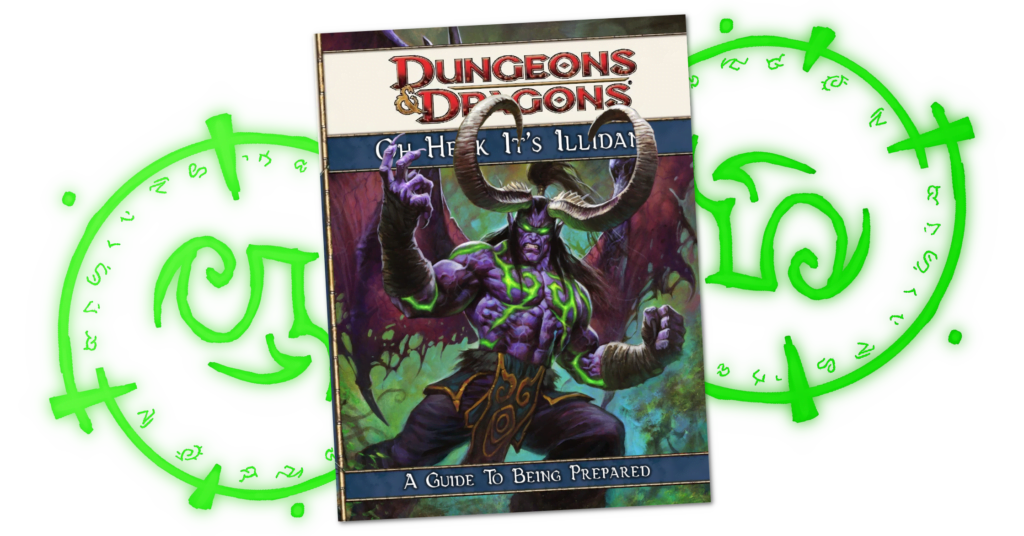
Story Pile: Toy Story
Toy Story is a 1995 animated feature film by Pixar Studios, distributed by Disney, that serves as one of those iconic examples of early 3d Animation that ‘holds up’ over time by people who haven’t gone back and looked at any of the humans in it. With the voice talents of Tom Hanks and Tim Toolman, it follows the narrative of a pull-string cowboy doll competing with a kung-fu action grip spaceman toy for the attention of their gigantically towering owner, whom they must never allow to know that they live, breath, and know his name.
For kids!
Look, classic yada yada, groundbreaking yada yada, wholesome yada yada. I actually got to see this one while inside a controlled christian media bubble, and if tomorrow I found out all copies of it had been deleted I would react like that ‘oh no, anyway,’ meme. It is not a movie for which I have an enormous amount of affection. I don’t want to talk to you about the narrative, though, not of Wilson’s Best Friend negotiating with the Last Man Standing about which of them will be more validated by an actual literal child and the ontological questions of why aren’t the parts of Mr Potato Head independently alive?
I want to talk to you about the humans of Toy Story. Specifically, about Andy, and Sid, and the weird world they live in, and the weird world they’ve created.
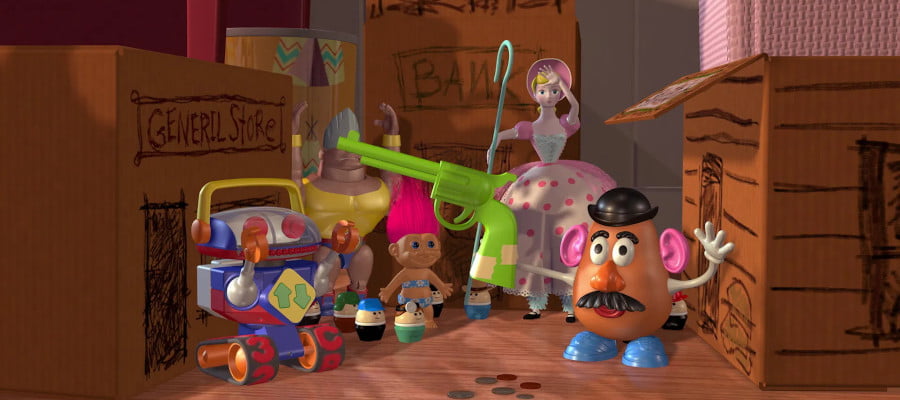
4e: Mind Control
Content Warning: I’m going to discuss some mind control stuff in ways that violates consent. Not any specific outcomes from that, but if you find the whole vibe icky, that’s what this is about.
Also, other, I guess, content warning: This isn’t about the horny topic of mind control, so if that’s the vibe you’re hoping for, sorry?
Rather what I want to talk about here is the way Dungeons & Dragons uses Mind Control across its multiple iterations and how, as tends to happen when I talk about it, 4th Edition did it in the best way.

CoX: Boss Rush
Time to time, I write up an explication of characters I’ve played in RPGs or made for my own purpose. This is an exercise in character building and creative writing.
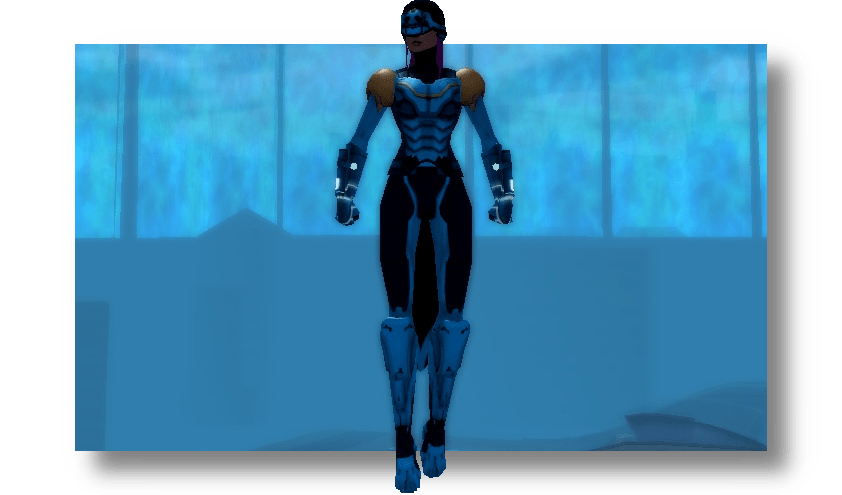
All the power in the world doesn’t matter if your mind can’t bring it to bear. There’s this whole study of the way brains ‘chunk’ information, neuroheuristics, the way the brain sets up tools for learning and managing what it’s learning about.
Rush was able to make the system containing the hardlight point nanites – but she needed a heuristic to manage the information. The result is her immensely powerful, immensely flexible tech rig, a kind of super suit made to be lightweight, transportable, and heavily adaptable, as long as the wearer can manage to explain to the device what she needs.
The gamer nerd and the tech geek collided, and thus, the hero identity Boss Rush was born.
Continue Reading →Game Pile: Hard Wired Island
Disclosure: I backed this book on kickstarter, and contributed art to it. I designed the flag of Grand Cross. I was not paid for this work, and asked for my payment to instead be given to charity. I’m friends with the developers – like, we know what kind of anime one another likes.
You can go get Hard Wired Island on itch.io and DrivethruRPG.
Fundamental, Parallel, Synthetic
There is an ongoing struggle in how we want to talk about games when it comes time to talk about their complexity or accessibility. And even there, in that sentence I’ve already kinda fouled up, because there’s an assumption there about what makes games accessible.
There’s this term we use a little bit called gateway games, which tends to get used to describe games that are reasonably approachable, often in a small box, and don’t tend to need a lot of emotional or narrative investment. These games tend to be abstract, though aren’t always – you may see Coup or Resistance referred to this way, as well as other games like Werewolf.
Now, the term ‘gateway’ isn’t honestly very nice: it’s primarily used to evoke the phrase gateway drug, which is itself, a dumb term because it was used to try and demonise Marijuana, and that’s all fraught with the racism of the war on drugs. And games aren’t, despite what you may jokingly say, drugs. Drugs are drugs.
There have been some attempts to get different terminology for this kind of game. Introductory games is one common category, but that creates the impression that the games exist to get you into other, ‘better’ games – there’s an implied progression. I also have heard foundatoinal game, where the games serve as a solid foundation for understanding game mechanics. That’s not a terrible term, but it also has that implication of progression.
What I use now, when I talk about this to students, is the three terms of fundamental game, parallel games, and synthetic games.
A fundamental game is a game where there is, essentially, one system. Again, Codenames and Werewolf fit in this space. There’s a very limited amount of stuff a player can do. It doesn’t have to be simple – after all, games like Crokinole and Bowls are games of a single system, but anyone who plays them will tell you the enormous challenge represented by just getting better at the games. Most sport games are fundamental games: One major mechanic, with everything just in service of that.
Parallel games are where there are numerous systems but they don’t necessarily interact. A Parallel game may let you focus on a single element, like your victory point salad games. A parallel game may also be a game where those different systems are things you can learn and focus on in your own time – consider how in American football, there’s a distinct set of skills for defensive and offensive play. Those are two systems that work in parallel with one another. Still, you can check out a host of games where players can ignore systems to engage with what they like to see parallel games.
Finally, there’s synthetic games. A synthetic game is one where all these mechanical entities are working in synthesis, where it’s impossible to extract one from another – where each system is used to mark or relate to another system. Complex games like this tend to be hard to tease out for separation. Look at Minecraft, where any given system is being made to the demands of another system, or Agricola, where all the systems are constantly tugging against one another to meet needs or create new ones.
There you go. A simple little bit of game language.
MTG: Winota’s Riders
Hey, I got curious about this idea, why not tell you about it.

Making Video: Outlined & Unscripted
Hey, one of the things I try to do is put the tools for making in other people’s hands. I realise that while I’ve been making videos, I haven’t done much to make it clear how I’m making videos, and what I’ve learned.
Here’s one of my older videos, and below the fold, my recording of how I made it.
Story Pile: BNA
BNA or BNA: Brand New Animal or Oh No I Guess I’m Hot For A Tanuki Girl Now Does This Make Me a Furry is a 2020 anime from Studio Trigger, the people you recognise the second you see their animation work, formerly of Kill La Kill, Little Witch Academia, DARLING in the FRANXX, SSSS.GRIDMAN, Promare, and a ton of other work including Indivisible, Flip Flappers, KILLER SHERLOCK, Akame ga Kill!, Steven Universe, Sword Art Online, and Space Dandy, and only one of them I made up.
BNA starts out with a tanuki girl crossing the boundary from conventional society to make her way to Anima City, the one city on earth, we’re informed, where human-animal hybrid shapeshifters can live, outside of the oppression of people who don’t transform, and therefore, view those who do with a sort of fundamental dehumanising horror. It’s, you know, furry racism, except handled a little bit less embarrassingly than normal.
The First Queen Controversy
What do you know about Chess?
It’s a well known ruleset, with layers of knowledge. There’s a set of strategies that are often treated as rules by high level players. Then there’s the layer of official ‘rules’ like castling and first pawn movement and how kings can’t check kings, which you find out if you play enough, and the first time you find out about it is embarrassing because the other player has to convince you, that, uh, no, they can totally do that. Then the layer above that is the way the pieces move, then the layer above that is what the pieces are.

And that’s kind of where this anecdote comes from.
I don’t know what Chess piece is, as it were, ‘the best known’ piece. I could run a study, but I don’t care, and neither do you. If I had to guess, I’d assume the leading piece is the Rook, probably the Knight after then (‘the little horsey’ being a joke), and the pawn is probably the one most used.
But famously, the most powerful piece on the board is the Queen.
She’s also one of the newest pieces to behave the way it currently does. Originally, the piece we call the Queen was ‘the vizier,’ and it basically operated as just King 2: Not As Good. The Vizier didn’t give you a lot, and it is generally clear if you run lots of math that it’s basically the worst piece in the game – it starts out locked behind a pawn and your reward for it is a worse piece than an aggressive king. It’s not a good piece. They experimented with giving it the ability to hop over a piece, but broadly speaking it wasn’t that important a piece.
Now, the name of the piece did evolve over time: It went through names like ‘tsarina’ and ‘king’s daughter,’ but its rules didn’t get updated until around the 15th century. That’s when Spanish players introduced a variant rule where the Queen moved as far as she could. This idea became known as, I kid you not ‘Madwoman’s Chess,’ because the sheer remarkable ridiculousness – a woman! Capable of doing that! Amazing!
On the other hand, this variant was really good, and it added strategy, games ended faster and more decisively, and the Queen piece was suddenly worth the effort it took to peel her out from behind a pawn.
And then the complaints started.
Because why was a woman piece being given that kind of power?
There were complaints, in letters and in forums, about this chess variant, about the idea that it was terrible to give a ‘queen’ that kind of command over pieces that were male (they were?), and that this would open the door to abuse and maybe even convince women rulers they were in charge, and then, then, why… why what would we do then?
Anyway, most of these complaints split pretty cleanly: Italian, Spanish and French players liked the rules variant, because it was fun, and most of the complaints were in English. And you’d be surprised but 15th century nobles found it really easy to completely ignore the opinions of people who spoke different languages to them. It wasn’t some enlightened feminist statement, not at all – it’s that the piece was already called the queen, a game could be made better by changing her, and the people who objected could be dismissed as being, you know, English.
Anyway, death to kings.
🧊 The Ice Type 🧊
The Ice type, in Pokemon, sucks.

Game Pile: Usurper
I went on a bit of a rollercoaster with Usurper.
First, I backed the game on kickstarter because it had some very modest targets, and a nice aesthetic, and stated it was using Gamecrafter. I thought it looked like a very good early effort for a game designer, backed it, and forgot about it for a few months.
Then it arrived.
What arrived was, as a game, a really robust little draft-position-play kind of game, with a thematic space I can only describe as ‘excellently obtuse.’ I had a look, I considered how I was going to approach talking about this game, and I put together a little list of thoughts that I laid out in the template for this article. As part of doing that, then, I went to get my due diligance and the links to people’s works, and places where you can buy the game, and found, to my surprise…
You can’t.
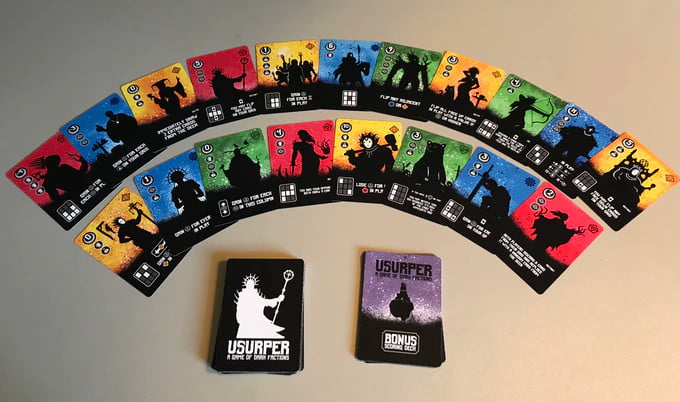
Should Megatron Even Be A Gun?
The classic villain of the Transformers canon is the generically named villain Megatron. In almost forty years of reimagining and endless marketing, we have seen Megatron in a lot of different ways. He’s been an unassailable, all-powerful figure at the top of a hierarchy, a strongman ruler who can oversee an army, a gatekeeper of power, a rebel leader attacking an empire, a damaged soldier, a gladiator and an avatar of oblivion. Across the major histories of Transformers, Megatron’s image of himself has varied, from series to series, writer to writer (and in particular projects, episode to episode), but it is reassuring to see how consistently this character is recognisably himself.
Of course, to know that, you’d have to watch a lot of transformers media, and that’s not how lots of people partake of them. Most people, at least, most of the people who don’t watch the Bay movies and think ‘oh yeah that’s about right,’ bring the same thing to mind when they talk about Megatron.

3.5 Memories: The Palingenesis Of Xen’Drik
Content warning: I can’t help myself from bringing up the Nazis.
I’m not joking.
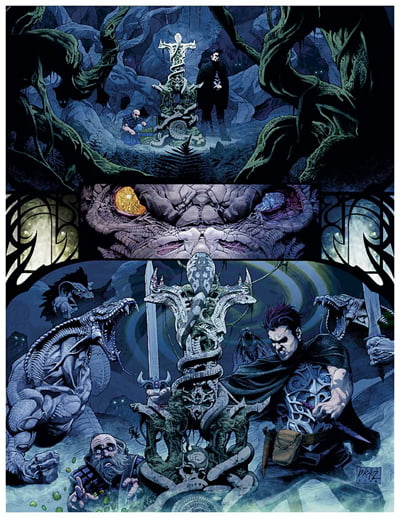
The Fuck You Rain
Okay, okay, I want to jot this down.
I’m writing this on the 25th of March. Scheduling means this isn’t going up until May. But cast your mind back to those days, we were so innocent, so youthful, everything was different back in March and oh god I hope that’s not true. Point is though, this is the first time this blog has needed a timely post and not been able to just bump things for it. Wild, huh?
Thing is, this week has been rainy. In fact, in my area, it’s been raining for two weeks, and specifically it’s been raining nonstop for ten days up until yesterday. From me, now, the 25th, not uh, whenever you’re reading this.
If it’s raining, there’s stuff that doesn’t happen. People aren’t going places as much. If I go to the store, it’s because I’m getting a lift with a friend or getting the bus, and getting the bus in the rain sucks. Still, things need to be done because they need to be done so they get done but some things you can’t do.
Like laundry.

Today, it was sunny. It was bright. It was twenty eight degrees. So if you were like any normal person, like, say, us, you did a load of laundry, first thing in the morning and you bolted out to get it up, on the line, in the blazing morning sun. You got your stuff drying as fast as possible after almost two weeks of not being able to get a load of underwear clean. And it’s Australia, so it’s sunny as hell when it’s sunny, and that means that you wind up, right, with a nice, reassuring warmth that says yes: The laundry will get done.
And at like, noon, today, suddenly, a peal of thunder
The heavens opened.
And for twenty solid minutes there was just a vertical river of a rain that as far as I can tell, served no greater narrative purpose than to ruin the day of every single neighbour we have who was sensible enough to do the clever thing and put their laundry out to dry during this blessed wellspring of warm sunlight. And the thing is, the thing is, it’s not just that your laundry got rained on for twenty minutes – it’s worse. It’s worse, because when it was raining you had no idea it would pass.
If you saw this rain, you’d look at the sheet of water out of the sky and your struggling t-shirts and go: well, fuck, I guess I need to get out there and rescue whatever dryness they have. You bolt out in the water and splash around in the water that’s puddling in the backyard under the line, or the mud, and you’re not dressed for this rain, because it’s a hot day up until exactly this point. And it sheets down over you and you get the laundry in off the line and bolt inside and then you look at the laundry and
let’s face it
It’s soaking wet.
You didn’t save shit.
And then, like, maybe two minutes after that? The rain stops. The sun comes out. And the rest of the day is warm and sunny.
But can you trust that?
I did not get caught in this storm, mind you.
I’d forgotten to do the laundry in the morning.
Story Pile: Moneyball
Lots of movies are about games. Most of them are kind of bad – sports movies famously depicting weird strategies or rules loopholes or just bad versions of how their games are played to create the most dramatic moments. And if your sport is one of the heavily merchandised sports in the United States, your sport has absolutely got a set of movies, filling the niches of What If Sports, What If Sports But Girl, What If Sports But Animal, and eventually, What If Sports But Your Dad Cries. Moneyball is firmly in that last category, a rhapsodic story about how important a game Baseball is to culture, which is why it’s mostly only played by three countries, and I know someone’s coming along to go hey, you forgot Poland and I do not care.
Ostensibly, Moneyball, a 2010 film about a 2002 season of ‘Baseball,’ the 1845 game, follows Billy Beane, a lone, hard man, a bitter and tormented man, a baseball man, where he took the conventional wisdom to the table, rejected the model of running a baseball team and defeated the system with facts, and logic, showing that once and for all, baseball doesn’t care about your feelings.
I promise, promise, promise, this tone is necessary.
Because Moneyball as a movie owns bones.
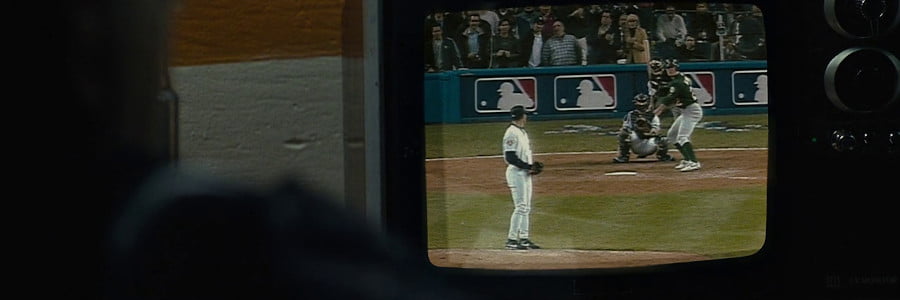
O Whacking Day
I am not actively a big fan of the Simpsons. I mean, they’re part of my sense of humour, I know a lot of the memes, I get a bunch of references but that’s because The Simpsons is a kind of cultural background radiation. It’s not something I’ve actively watched on TV at any point in the past twenty-five years, which is kind of amazing to consider. Like, I haven’t watched an episode of the Simpsons since I was back in the cult, it was that long ago, and yet I’m reasonably conversant on the whole subject.
It doesn’t matter, though because apparently, the majority of the stuff The Simpsons fans reference all came about in that five year window, and I’m sure that there’s no other influence on this like the age of my friends. Based entirely on this I will simply assert that this is when The Simpsons stopped being good, and never bother thinking about anything after that point.
One episode in this ‘classic’ period, and the one which asks us to celebrate it tomorrow – I tell you early so you can get organised – on May the tenth, is the twentieth episode of the fourth season episode (blaze it), Whacking Day.

5 Alternatives To Classics
In literary circles it’s not uncommon for core texts to be seen as fundamentally important, perhaps because of their long-term impact, or their origination of important ideas to a particular grouping of texts. This is seen as one of those ideas that can legitimise a field – it’s not so much that videogames have been waiting for their Citizen Kane as much as is that they’ve been waiting for their advocates to be taken seriously inside and out of academia.
In board games, this conversation about a ‘canon’ is even harder to manage – it tends to be not about games as critically meaningful units of culture, because that’s… that’s real hard. Typically instead we get sales numbers, and that can create the idea that the gaming marketplace is itself fundamentally rational and never elevates anything bad and there’s no such thing as a distribution network.
Now, I think some of these ‘classic’ games aren’t… really interesting to me. And for me, as long as I have some games in my collection, I feel replace or displace other games in the same general field. Don’t think ‘I have to get these classics,’ just give them a play and see if you like them. There are almost always good alternatives, and now I’m gunna talk about some.
Continue Reading →Game Pile: Hyrule Warriors, Part 2
Here’s the video:
Knowing You’re Being Tested (If You’re A Thing)
There’s a term in AI Safety, coined I think by Robert Miles, about the dangers of test protocols and devices that can respond to them. The idea as he proposes it is that in the context of an AI that is being tested to see how compliant it is to a task, if it recognises the difference between a test and a real environment, it makes sense for the AI to lie about its own behaviour, pass the test, then execute things by its normal protocols.
The idea runs pretty much like this: AI as crafted have priorities. Let’s say it wants to press red buttons and not blue buttons. You want to make sure it presses blue buttons and not red buttons. So, you pull it in for a test. If the AI is capable of telling it’s being tested, the best way for it to continue pressing red buttons is to in this moment, press blue buttons to pass the test. There are more red buttons in the world then there are in the test, so it stands to reason that pressing these blue buttons will yield more red buttons over time.
And so you pull the thing into a test environment and it presses the blue buttons the way it should and you release it and still keep getting reports of all these red buttons being pushed. But because the AI behaves the way it ‘should’ in testing, you’re left with this really weird black hole in your ability to locate the problem. After all, the AI is doing what it should in tests!
This is a phenomenon that doesn’t just apply to high level AI though. It’s more a sort of general warning about the way testing environments are constructed, and what you have to do to deal with actors in testing spaces that are trying to pass the test. When playtesters are trying to convince you they had a good time, when they are concerned about your emotional reactions, they will do things that try to end the playtest session. They will be trying to live up to and comply with your expectations.
It’s also about the tools you use. Forms for feedback can unconsciously push people towards giving you the answers you want rather than the answers they intend to give. This is especially true for any testing involving kids, because kids are inclined to giving emotional responses that they perceive you want. What’s more, kids are really good at inferring the unstated – so if you ask them if thing A is true or false, they may often infer thing B, even if you don’t want them to.
The important thing is that your test results and feedback can get all sorts of unconsidered factors. It’s worth noting that Robert Miles’ position was explicitly about things where a thinking entity made a deliberate choice to disrupt the test, though.
The term he uses for this is Volkswagoning.

Minecraft: XP Furnace Design
Back in the days of Minecraft’s 1.15 patch, I shared this picture on Twitter:

This is something I was working on in a creative world for a collaborative server space. What I wanted to make was an XP Furnace system that could be used for players who needed to repair their mending equipment conveniently, something that just worked on its own over time. This design was made to be tileable, where each piece could be put directly next to one another without interfering with one another, and to be user approachable. I didn’t want a user to have to do anything with it – just let them take the stuff out of the furnace and get the XP that the furnace had in it was the ideal.
Harmonising the Jedi
There’s this idea in religious studies, but usually something you only examine as a member of that religion, where you try to take conflicting or seemingly conflicting incidents in different texts and try to construct an explanation for how those things work together. This idea, of trying to bring these works together, is known as harmonisation. It’s a way that multiple conflicting canons – in the religious sense – can be ‘explained’ into one another. It also, when you understand it as a practice, makes a lot of changed texts make sense.
Like Star Wars movies.
Continue Reading →Story Pile: Tenchi Muyo (Kinda)
Stop me if you’ve heard this one, or one like it.
The story starts in a remote, boring little bucolic space where nothing is happening but there’s talk about an old mystery that connects to a family line. Our hero, Tenchi Masaki, wants to go explore the interesting thing, but his grandfather tells him he has to do his chores, instead. When he slips from his grandfather’s attention, he winds up exploring an old cave he’s been told not to, whereupon he gets a sweet laser sword that’s a relic from a more civilised age, and also wakes up an ancient demon, which kicks off a series of events resulting in his whole house being teleported next to the same bucolic shrine, meaning it’s easy to hide spaceships coming and going, and you don’t have to draw as many backgrounds in a city or non-major characters.
Along the way, he discovers the demon is actually a cool space pirate who wants to jump him, she’s being hunted by a haughty princess, who wants to jump him, and then a steadily coagulating core of Other Girls arrive to join in the queue of Wants To Jump Him.
It’s not a hentai.
There’s spacefaring adventurers, battles with galactic criminal types, a vast interstellar empire, and deep powerful forces that well up from inside Tenchi (who is secretly a prince).
Now I may have described The Most Generic Anime Plot ever, but the good news is that’s because I also described The Most Generic Anime ever, an anime that has been part of the background of anime for a while now.
Content Warning: Mentions of incest.
Continue Reading →Bidding for Second Place
I have this game idea where it’s a bidding game, but the second place is the one that wins it.
That’s it, that’s the whole of the idea.
There are a couple of games that already work on this principle. The idea that you want to avoid overdoing your efforts to hit a target is something that’s been in games since, well, Snakes and Ladders, where you have to land on the last tile with the exact, correct roll. Curling and Bowls are both games about getting as close as possible to a target without actually touching it, which implies the same vision of doing ‘exactly enough.’
In the case of the auction game, though, you aren’t sure about what you’re trying to do; you aren’t just expending resources that you want to save, but you’re also trying to hit just behind the player who bids the most. I think there’s interesting tension there, in the form of being second.
The problem I’m wondering about is what kind of theme can fit this?

In an auction, the idea that the first place loses the thing somehow is confusing. I can’t imagine why someone would do this, unless the auction was deliberately set up to be unfair. Blind auctions in the real world sometimes have rules like buy-in, so you have to place a bid in the hopes of getting something and you may not even get all the money you bid back, which is a great swizz for people engaging in these kinds of nonsense trades.
The problem is that auction games about auctions are… weird? They need something to justify the mechanics, why they’re not just, you know, an auction. Consider that many auction games rely on expending resources that are limited – like cards. In the real world, money’s fungible – so you can just make change and bid the amount you want. Once you start introducing game mechanics to auctions, you need to introduce enough that they explain why the auction is being run like a real mickey mouse outfit.
Here then are some thoughts about what this ‘hit second’ auction may be all about:
- You’re bidding on religious iconography, and the church keeps identifying the richest person based on the high bid, swooping on them to demand tithing
- You’re extremely exciteable idiots, meaning that ‘winning’ the auction results in you throwing a huge party immediately, and forgetting to pick up the item
- You’re raiding hackers, and the first person to break a server are the people who are immediately driven away – you get prestige, but not resources
- You’re all contingents of a raiding army – the highest value represents the biggest army, which is put to the task of destroying enemies, while the second biggest must do the work of developing the land
- You’re Canadian, and too polite to take the thing if you win
- You’re artists working in a fragile medium like ice, and the person who tries to do the most has their artwork collapse
- You’re dealing with rallying Australian voters, and Tall Poppy syndrome syndrome means the top position loses
- You’re cultists rousing Cthulhoid horrors – and the cult that gets too much attention gets eaten
- You’re smuggling stuff past cops, and the people who move the most product are the ones who get caught.
What about you? Got some ideas?
The Cataphasis of Haruhi Suzumiya
Anime is an art movement that has encapsulated thousands of different competing threads and there’s no true centralising canon because it’s fragmented across all sorts of cultural anchor points. Australians of my age that are into anime so often got started because Aggro’s Cartoon Connection screened Sailor Moon, the ABC screened Astro Boy, Cheez TV screened Teknoman and SBS, in the late 90s, screened Neon Genesis Evangelion, meaning that those four anime are sometimes seen as ‘common ground’ topics. Common ground for one age bracket in one country, and even then, only sometimes.
There are some events that can be looked upon, in the english-speaking anime fandom, though, in terms of their impact on shared cultural spaces, typically conventions, but also just, anime releases that somehow managed to be widespread enough at the right time that they became foundation to the conversation. The big three of Naruto, Bleach and One Piece. Evangelion movies. Fullmetal Alchemist, then Fullmetal Alchemist again. A collection of trans girls and boys and nonbinary people that can trace a lineage from Ranma 1/2 through to Kampfer and Haku and Soul Eater and maybe a few tracing lines to Vandread.
There is a category of people I can annoy enormously by responding to a Touhou picture with which anime is this from?
There’s only so much room for any given series to suck up a lot of the oxygen in the fandom space. You can’t typically have five or six ‘big name’ anime that ‘everyone’ has an opinion on. One of those ‘event’ Anime, that rose, became incredibly prominent, and then deformed the culture at large, becoming one of the rings in the tree trunk that is this strange cultural enclaves, was the enormous franchise known as Haruhi Suzumiya.
